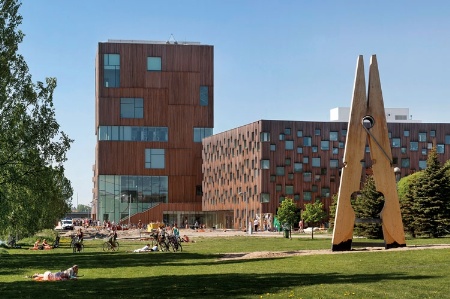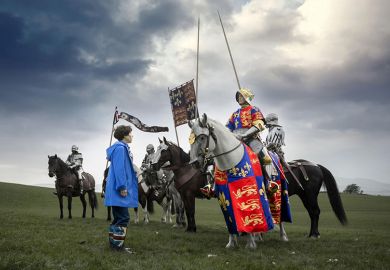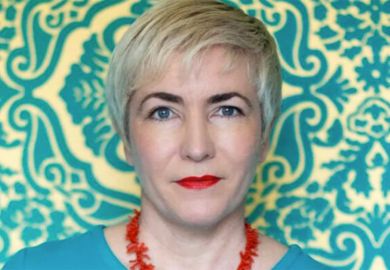Source: Roger Degerman
Swedish riffs: Guitars – The Museum opened as part of the Umeå2014 festival
The first four European Capitals of Culture, starting in 1985, were Athens, Florence, Amsterdam and Berlin. But if the initial choices were already very well known on the international tourist circuit, recent years have brought some much lesser-known places to the world’s attention, from Sibiu in Romania to Turku in Finland. In 2014, Umeå in northern Sweden shares the honours with Riga in Latvia.
Capital of Culture status gives such cities, their cultural institutions – and their universities – an opportunity to raise their profiles in a way that is hardly meaningful for Paris or Madrid. In preparation for Umeå2014, reports Britta Lundgren, professor of ethnology at Umeå University, “the vice-chancellor decided in late 2011 a special assignment for establishing the cultural dimension as an important part of the university”. The aim, she says, was to “contribute to strengthening the development of the university” as well as to be a “positive force” for increasing awareness of the institution abroad.
In such a young, comparatively small but fast-growing city, the university is already a major presence in its life and culture. The Bildmuseet, Umeå University’s museum for contemporary art, is located on the Arts Campus, which has enjoyed much recent investment and also houses the School of Architecture, Institute of Design, Academy of Fine Arts and HUMlab-X (“a vibrant meeting place for the humanities, culture and information technology”). This provides a range of venues for Umeå2014, and the university intends to build on a 10-year tradition of free lunchtime Culture on Campus events, which academics, students and administrative staff have long enjoyed.
Lundgren’s task was to coordinate plans between different departments by bringing together a core group of about 50 people from most disciplines. Because they are largely operating within their normal budgets, she says, they have aimed “to connect Umeå2014 to the core [university] activities – eg, research, teaching and outreach. For 2014, we have tried to make something special out of these core activities, whether it is research, conferences, book projects, educational activities, posters and exhibitions, open house events, interactive events or strictly cultural events.”
She adds that where possible, the university has tried to link its projects to the eight seasons of the Sami – the indigenous people of the northern European Arctic – “that are the main idea for the whole cultural year” for Umeå2014.

Given its location, it is hardly surprising that the university’s Centre for Sami Research (CeSam) is a major hub for studies in the field. The Bildmuseet is holding eight exhibitions featuring different Sami artists, the first two exploring northern landscapes and “the studies of Sami people undertaken by the State Institute for Race Biology in the first half of the 20th century”. CeSam has forged a new interdisciplinary link with the chemistry department to create an exhibition and lecture series on Sami medicinal plants and the Sami art of healing. And the department of food and nutrition will be serving up Sami menus.
Pop-up talking shops
The Umeå2014 umbrella is also useful for bringing to the city at a particularly lively time mobile conferences that could in theory be held anywhere. There will be about 25 at the university during 2014, among them a “mathematics biennale”, one addressing gender and power, and one organised by the University Network of the European Capitals of Culture, which was founded in 2006 “to stimulate new forms of academic and educational institutional collaboration”. Most significant of all is the “Design, Research, Society” conference, to be held over the festive Swedish Midsummer at the Umeå Institute of Design, as “a forum where the questions that have the potential to change the way we think and do design – its philosophy, theory, practice, methodology, education, profession and history – will be discussed and debated”.
Although it is still early days for this year’s Capital of Culture, the university’s department of culture and media has already participated in Littfest 2014, Sweden’s largest literary festival. A vast new guitar museum has opened (and is now hosting an exhibition on Umeå – The European Capital of Hardcore 1989-2000). As the temporary events and the new permanent attractions will surely draw many visitors to the city during 2014, a smartphone and tablet app has also been created to help them navigate the campus.
But what does the university in the most northerly of all European Capitals of Culture seek in the way of long-term benefits? Lundgren is looking for solid results in research and new cross-disciplinary collaborations, but she also wants to see a payoff in terms of attracting more Swedish, international and exchange students. The autumn 2013 “Caught by Umeå” roadshow of Copenhagen, Warsaw, London, Amsterdam, Paris, Barcelona and Hamburg – which aimed to drum up interest in Umeå2014 – already seems to be bearing fruit in terms of students considering the university. “We’re seen as on the periphery,” Lundgren argues, “though actually we’re only an hour by plane from Stockholm.”
Register to continue
Why register?
- Registration is free and only takes a moment
- Once registered, you can read 3 articles a month
- Sign up for our newsletter
Subscribe
Or subscribe for unlimited access to:
- Unlimited access to news, views, insights & reviews
- Digital editions
- Digital access to THE’s university and college rankings analysis
Already registered or a current subscriber?






